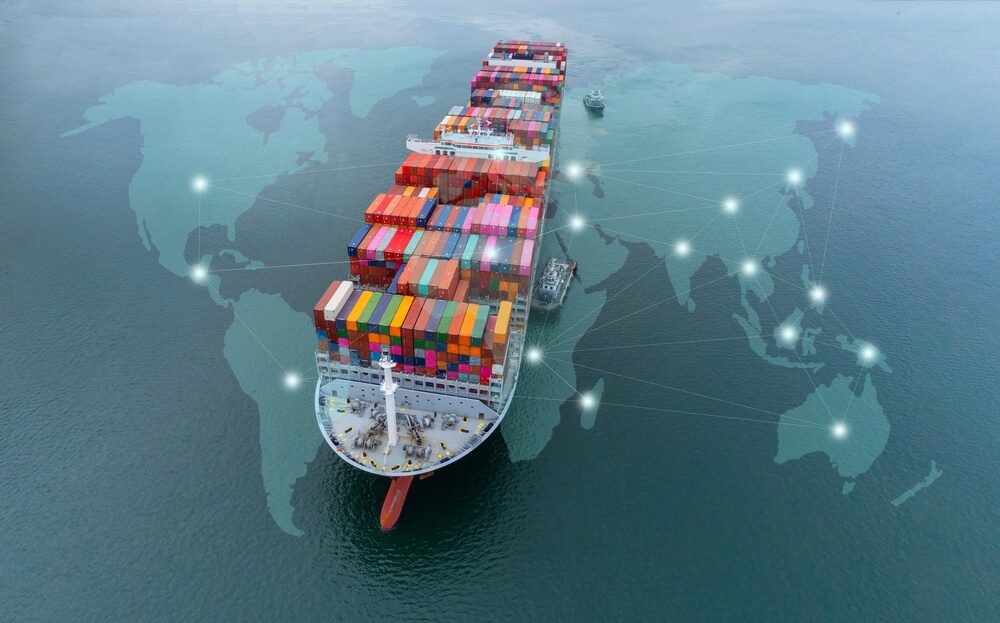
Like the ocean tides, dynamics between all the players in international shipping are constantly shifting. Let’s explore the factors complicating international shipping today — and how shippers can optimize their networks for smoother sailing.
From regulations to geopolitical concerns and beyond, shippers are still grappling with a number of factors outside their control.
The climate, as well as measures intended to mitigate climate change, continue to have a major impact. Shippers should always be prepared for climate-related disruptions, from droughts to typhoons. On the prevention side, cost factors may come into play. Pollution controls in California are pushing for electric dray trucks, which may increase fees on West Coast ports. This likely won’t be significant enough to require re-allocation to other ports, but it’s definitely a factor shippers should keep an eye on.
Geopolitics continue to be similarly tumultuous. Shippers should monitor the countries where they buy or sell for incidents and unrest. The Russia-Ukraine conflict shows no immediate signs of resolving and may soon involve neighboring nations — diminishing services and increasing costs in surrounding areas. In the United States, this year’s train derailments (and politicization of them) may drive additional regulations on rail operations — resulting in higher rail costs, slower transit times, and perhaps even increased insurance costs.
Container shortages in 2020 compelled container owners to raise their prices, terminate leases early, and order more new containers to replenish the supply. Lessees, in turn, began to sign longer contracts to ensure adequate capacity. Now that the market has flipped, we see more short-term pricing in effect with three to six-month agreements. This allows shippers to maintain more flexible budgets and provide the steamship lines with accurate forecasts to secure available capacity.
On the vessel side, capacity shortages in 2020 and 2021 drove carriers to place more vessels on order. As that capacity continues to increase, carriers are responding by lowering prices to ensure both old and new vessels are operating near capacity, retaining current or higher prices in the face of greater capacity, and even slow-steaming to avoid excess emissions and dwell times at the ports.
Clearly, the seas are still choppy. But there are a few steps and considerations shippers can take to make ocean shipping smoother, more efficient and more profitable.
Diversification is an essential element. If a shipper’s supply chain looks more like a supply line segment than a network, then they need to consider backup plans. Similar to a strong IT system, modern supply chains should have redundancy and duplication of critical resources built into the system. These measures do not come without a cost, but in these uncertain times, they are worthwhile insurance against stockouts.
Strategic re-evaluation of steps all along the chain should likewise be considered. Wherever overall costs allow, shippers might consider distributing to several smaller, geographically dispersed warehouses served by different ports rather than one large one served only by one. Shippers don’t need to own and operate all their own warehouses; critical stock can be delivered through a myriad of flexible warehousing and distribution services offered by third parties to save on overhead costs.
Collaboration is similarly important. As a survival mechanism during the pandemic, collaboration and transparency increased among partners — and even competitors. And although COVID is largely in the rearview, we should expect those practices to persist. In response to pricing and capacity, three-month contracts here are likely here to stay. It allows shippers to give projections and the fixed pricing protects both parties. In addition, planning with pre-carriage and on-carriage, terminals and warehouses allows for all of the other legs in the journey to be set up for success and adjust as the forecast changes week to week. Operating international shipping in a silo is like cooking without salt: it’s possible but not ideal!
With the fixed contracts moving to shorter terms, shippers that have variability and last-minute needs are in a position where spot market rates and capacity are critical. We continue to see more technology offerings by both the steamship lines and especially freight forwarders, as well as transactional ocean shipping marketplaces popping up to address these needs.
In the spirit of collaboration and transparency, there are several questions shippers should be asking their logistics service providers (LSPs). What is their strategy for staying competitive in 2023, including technology, services, and price? How will the LSP support the beneficial cargo owner’s (BCO) business strategy? How will the LSP respond to events such as changes in business or major disruptions? How are they improving visibility or reducing fees like detention and demurrage? The answers to these questions might inspire better practices across supply chains or at least inform a shipper when it might be time to search out better partners.
In recent years, supply chains have felt unpredictable at best – and tempestuous at worst. And from conflicts to climate change, they may never be truly stable. However, there is no shortage of strategies at shippers’ disposal to help them successfully navigate these unruly seas. From diversifying assets to re-evaluating relationships, shippers have the power to begin optimizing their networks today, and preparing themselves to ride out whatever wave might come next.
External pressures and shifting dynamics can make ocean shipping challenging. Equip yourself with real-time ocean visibility from FourKites for smoother sailing and strategic insights. Don’t be left adrift; chart a clear course today.